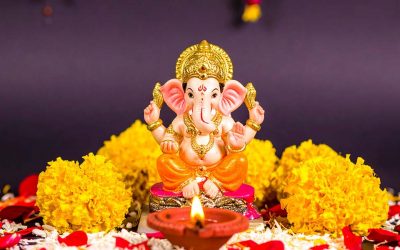Why is Saraswati puja done on 6th day of Navratri?
Saraswati Puja is one of the most significant festivals in India. It is dedicated to Goddess Saraswati, the embodiment of knowledge, wisdom, music, and the arts. It holds a significant place, especially during the festival of Navratri. The timing and rituals associated with Saraswati Puja differ across regions in India, reflecting the rich diversity of traditions.
Who is Goddess Saraswati?
Goddess Saraswati is the goddess of knowledge, wisdom, speech, and the fine arts. She embodies purity and enlightenment, symbolizing the power of knowledge that dispels ignorance. Depicted gracefully seated on a white lotus, she plays the Veena, a musical instrument that signifies harmony and creativity. Her attire is a white sari, symbolizing purity and the pursuit of true knowledge, and she rides a swan, which represents discernment and the ability to distinguish between right and wrong. The name ‘Saraswati’ itself has profound meanings, with “Saras” signifying a body of water or speech, and “vati” meaning woman, thus representing the “goddess of speech” or “essence of self.”

Why is Saraswati Puja Done on the 6th Day of Navratri?
On Saraswati Avahan (innovation), Goddess Saraswati is invoked. This day marks the beginning of her worship, signifying the triumph of wisdom and knowledge over ignorance. The reason for performing Saraswati Puja on the sixth day stems from the spiritual journey of devotees, who, after overcoming physical and material obstacles in the initial days of Navratri, now seek enlightenment, knowledge, and guidance from Saraswati Devi.
During Navratri, the first three days are dedicated to Goddess Durga, the next three to Goddess Lakshmi, and the final three to Goddess Saraswati. This progression represents a journey from physical strength to material prosperity, culminating in the pursuit of spiritual wisdom.
Saraswati Puja is observed on Navratri, aligning with the Ayudha Puja celebrations. On this day, Goddess Saraswati is worshipped for her blessings in enhancing learning and creativity. The tenth day is called Vijayadashmi, which marks the beginning of the Vidyarambham ceremony, where children are initiated into the world of learning.
Vidyarambham, meaning “the beginning of knowledge,” is another crucial ritual associated with Saraswati Puja, especially in southern India. Children aged between 2 and 5 years are introduced to letters and writing. They sit on the laps of elders, and with their guidance, they write the mantra “Om Hari Sree Ganapathye Namaha” on rice or sand. This ritual is believed to invoke the blessings of Goddess Saraswati, ensuring a prosperous beginning to their educational journey.
Significance of Saraswati Puja During Navratri
Navaratri represents the victory of good over evil and emphasizes self-reflection and spiritual growth. Performing Saraswati Puja to Goddess Saraswati, who embodies knowledge, wisdom, and artistic excellence, during Navaratri helps devotees seek her blessings to enhance their intellect, creativity, and communication skills.
Historically, Navaratri commemorates the victory of Goddess Durga over the buffalo demon Mahishasura, symbolizing the triumph of light over darkness. Mythologically, it represents the worship of the divine feminine energy, or Shakti, in various forms. One of these forms is Goddess Saraswati, which embodies knowledge, learning, and the arts. In South India, Saraswati Puja is considered an essential part of Navratri as it is dedicated to worshipping various forms of Goddess Shakti, including Goddess Saraswati.
Rituals and Customs of Saraswati Puja During Navratri
During Saraswati Puja, several unique traditions and customs are observed, emphasizing the importance of knowledge, creativity, and learning.
Kolu Display: Families create “Kolu” displays with miniature figurines of gods, goddesses, animals, and spiritual personalities representing the universe. Each day, special pujas and offerings are made to honour the Kolu display.
White Flowers: White flowers, especially white lilies, are offered to the goddess as they are known to be auspicious and attain Saraswati’s blessing.
Educational Materials: Books, pens, musical instruments, etc., are placed in front of the goddess as a mark of respect, symbolizing the significance of knowledge. Children with poor academics chant mantras to get Saraswati’s blessing.
Vidyarambham Ritual: The day after Saraswati Puja is called Vijayadashami, and the Vidyarambham ceremony takes place. Children between 4 and 5 years old are initiated into writing and learning with the help of an elder.
Ayudha Puja: It is celebrated alongside Saraswati Puja, where tools, weapons, and instruments used throughout the day for daily chores, warfare, or professions are worshipped. This ritual shows respect for the instruments used for professions and learning.

Benefits of Saraswati Puja During Navratri
Saraswati Puja in Navratri has several spiritual, intellectual, and practical benefits, which in turn help a person increase many aspects of life. Here’s how this sacred practice enriches your mind, spirit, and overall well-being:
Activates Intellectual Channels: It activates the “Medha Nadi,” the intellectual channel that sharpens understanding and comprehension. This makes it easier to grasp complex knowledge, aiding both students and professionals in their learning experience.
Calms the Mind and Improves Focus: This ceremony creates a sense of serenity and purification, fostering sharpness and better concentration. It mainly works for those who want to improve memory, concentration, and mental clarity.
Stimulates Inner Intuition: When performing Saraswati Puja, one connects with one’s inner intuition, more often making wiser choices and gaining a better overall understanding of oneself and what needs to be achieved.
Enhances Memory and Intelligence: Goddess Saraswati’s blessings help improve memory retention and overall intelligence, making it easier to absorb and retain information in studies or work.
Improves Creativity and Artistic Skills: The goddess of the arts blesses those devoted to her with more creativity and artistic skills. Her presence benefits musicians, writers, dancers, and anyone engaged in creative pursuits.
Enhances Vocabulary and Oratory Skills: Saraswati, the goddess of speech and communication, strengthens public speaking and presentations, helping you express yourself effectively.
Boosts Spiritual Growth and Inner Calmness: Saraswati Puja is not just about academic success; it also enhances spiritual growth in a person. The goddess’s divine energy connects with qualities like inner peace, clarity of mind, and, most importantly, a deeper meaning for life.
Defeating Obstacles: The puja builds capacity and wisdom to overcome difficulties in learning or in the profession. With Saraswati’s blessing, you develop enough confidence to face and tackle obstacles on the path and reach your goal.
Removes Ignorance and Cultivates a Love for Learning: This spiritual practice removes ignorance and encourages a sincere pursuit of knowledge, instilling a deep reverence for learning and education.
Saraswati Puja during Navratri is an invitation to the divine goddess’ blessings, including knowledge, wisdom, creativity, and spiritual growth. It will help you achieve excellence through any area-based development—academic, professional, artistic, or personal.
How to Perform Saraswati Puja at Home
- Start Your Day: Wake up early and take a holy bath to purify yourself.
- Prepare the altar: Set up a clean space with an idol or picture of Goddess Saraswati and decorate it with white flowers.
- Dress in Yellow: Wear yellow clothes, symbolizing knowledge and wisdom.
- Offer Sweets and Prasad: Place white sweets, fruits, roli, moli, and betel leaves before the goddess.
- Arrange Learning Materials: Place your books, stationery, and instruments before the deity.
- Chant Mantras: Light a lamp and incense, then chant Saraswati mantras.
- Offer White Garlands: Present the goddess with a white flower garland and a dupatta.
- Perform Aarti: Conclude with an Aarti, waving the lamp and singing hymns.
- Seek Blessings: Bow and allow children to recite shlokas, seeking the goddess’s guidance.
- Conclude the Puja: Sprinkle holy water, distribute prasad, and share your offerings.
Following these simple steps, you can perform Saraswati Puja at home and invite divine blessings.
Participating in Saraswati Puja is a way to invite the goddess’s blessings to illuminate your path, remove ignorance, and empower you to reach your highest potential. As Saraswati Puja approaches, VedaYatra invites you to connect with the divine energy of knowledge and wisdom. Let us guide you through this sacred tradition, inspiring you to pursue learning with passion, creativity, and devotion.
Book your Saraswati Puja experience with VedaYatra today and step into a world of enlightenment and knowledge!






